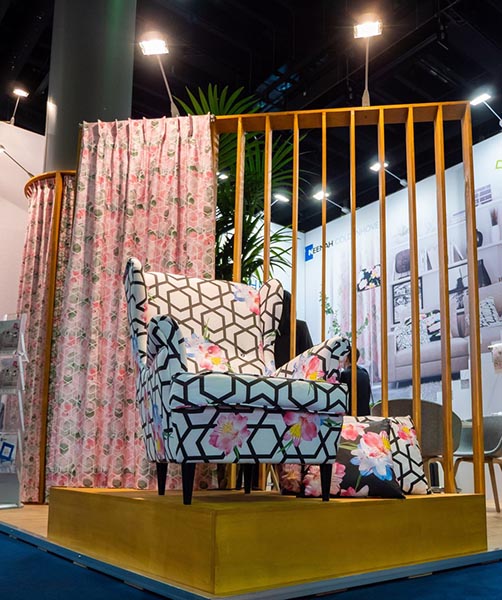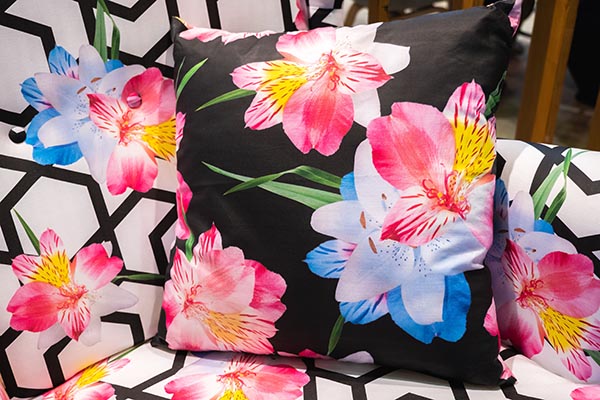The Future of Pigment Ink Technologies

At Heimtextil 2020, Neenah Coldenhove introduced a new digital transfer paper for natural fiber fabrics. Although an estimated 60% of apparel is made from polyester or polyester blends, that still leaves 40% that uses natural fibers such as cotton, linen and rayon. As pigment ink technologies improve, the industry has looked to those inks to increase the range of fiber types that can be printed digitally. To date, that has typically meant direct-to-fabric. That changes with Texcol, a unique new offering from Neenah Coldenhove, designed specifically for heat transfer onto natural fiber fabrics. We spoke with Gijsbert Harmsen of Neenah Coldenhove to learn more.
WhatTheyThink: Gijsbert, thank you for speaking with us about this exciting announcement. Although our readers are likely very familiar with Neenah Coldenhove, let’s start with a bit of background on the company.
 Gijsbert Harmsen: Coldenhove paper mill was established in 1661, and we were under private ownership until 2017, at which point we were bought by Neenah. It has been a good marriage. Neenah has a group of paper mills producing fine and specialty papers. Coldenhove has two paper machines. One of these machines primarily focuses on dye-sublimation papers. In fact, we have produced sublimation papers for rotary screen printing since 1970. In 1996, we began to consider the potential of analog printing moving to digital and determined that we needed a paper that covers digital printing. That led to the invention of the first digital dye-sublimation paper and Coldenhove’s entry into digital printing. We are a market leader since then, and had a patent on that paper that was valid until last year.
Gijsbert Harmsen: Coldenhove paper mill was established in 1661, and we were under private ownership until 2017, at which point we were bought by Neenah. It has been a good marriage. Neenah has a group of paper mills producing fine and specialty papers. Coldenhove has two paper machines. One of these machines primarily focuses on dye-sublimation papers. In fact, we have produced sublimation papers for rotary screen printing since 1970. In 1996, we began to consider the potential of analog printing moving to digital and determined that we needed a paper that covers digital printing. That led to the invention of the first digital dye-sublimation paper and Coldenhove’s entry into digital printing. We are a market leader since then, and had a patent on that paper that was valid until last year.
WTT: What got you moving toward the development of Texcol?
GH: A couple of years ago, we began thinking about what would be the next generation of digital papers, and we saw that pigment inks were very big in analog decoration of textiles at 50%, but in digital, it was only at 3%. We believed that growth would most likely be in the pigment ink arena for digital textile printing in the future. So we started developing a paper that you could print with pigment inks and transfer to a cotton or cotton blend. We introduced the first sneak preview at ITMA 2019 with the goal of getting to know the market requirements better. We wanted a very controlled introduction. The market is very big, but we want to make sure we do it right.
WTT: You showed this on a larger scale at Heimtextil 2020; is it commercially available now?
GH: Yes. We continue to work with customers to optimize the paper. We have spoken to hundreds of companies, and they are telling us, “What you guys have is revolutionary.” But we are also fielding a lot of questions and requests from customers about what it should do with regard to washability, hand, crock, lightfastness, etc. Currently the version we have is Version 1, a paper with multiple coating layers. You print on the paper as you would do with any dye-sub paper. The only thing you have to do is change out the ink on any printer that can use pigment inks, such as some from Mimaki, Epson, MS, Reggiani, Ricoh, etc. It’s more determined by the type of print head and which type of pigment inks you need to use. We have tested all of these, and it works with all of them.

WTT: What challenges have you seen?
GH: The challenge we currently see is that the paper is very suitable for applications not in direct contact with the skin, because after the transfer process, the cotton has a coating on top of it that feels a little stiff. It’s not really suitable yet for fashion or bed covers or pillows. The Version 1 technology is better suited for things like partition walls, bags, hospitality curtains, sun screens. Our technological people are working on Version 2 that will be suitable for other applications. We can’t project right now when that will be available, but as soon as possible. The end point vision is a product with only two steps—printing and calendering—that will deliver colors exceeding what you would achieve with analog printing. We are still in a learning curve and are looking for customers who are willing to collaborate with us. We are asking them to send us fabric samples, which we will print and send back to them for feedback.
WTT: We are used to hearing about heat transfer dye-sublimation paper for use on polyester and polyester blends. You talk about transfer paper. What are the differences?
GH: Sublimation transfer paper has a coating which releases the ink under heat and pressure. During this sublimation process, the ink goes into the polyester fiber which has been opened up by the heat. After cooling off, the fiber closes again, and the ink is encapsulated inside the fiber. So with sublimation, the coating is merely a temporary carrier of the pigment of the ink. With transfer paper, the coating on which you print totally transfers to a substrate. So there is a 100% release of a paper coating. This means also that the ink is not inside a fiber, but on top of a fiber.
WTT: What about ink consumption?
GH: It delivers a huge savings in ink over direct digital printing, an estimated 33% less ink to get the same result. It also has good fastnesses; for example, a dry crock rating of 5 and a wet crock of 4.5. These characteristics are very good. There is also less waste with this process because you don’t have the feed-in and feed-out waste like you do on a direct-to-textile printer.
WTT: Are there limitations on fabric types?
GH: It doesn’t work on silk, and wool is too rough. But it works on pretty much all of the other natural fibers as well as polyester and polyester blends.
WTT: Does it require any pre-treatment or special coatings on the fabric?
GH: No, and that’s a good thing as it gives a massive environmental advantage.



